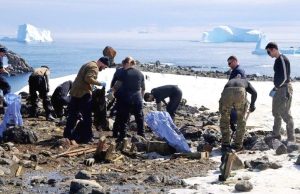 April 5th 2024, INDIA’s NCPOR 24th Foundation Day
April 5th 2024, INDIA’s NCPOR 24th Foundation Day
India’s National Center for Polar and Ocean Research (NCPOR) did organize an engaging cultural program titled “From Labs to Stage.” This unique event showcased the diverse talents of NCPOR’s scientists and staff, bringing them together in a celebration of creativity and entertainment.
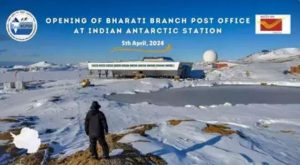 In this historic moment, as a part of the foundation day celebrations, the Indian Postal Services, in collaboration with NCPOR, inaugurated a new Branch Post Office at Bharati Station (WAP IND-Ø4) in Antarctica. April 5 was chosen because it marked the 24th Foundation Day of National Centre for Polar and Ocean Research (NCPOR), Goa.
In this historic moment, as a part of the foundation day celebrations, the Indian Postal Services, in collaboration with NCPOR, inaugurated a new Branch Post Office at Bharati Station (WAP IND-Ø4) in Antarctica. April 5 was chosen because it marked the 24th Foundation Day of National Centre for Polar and Ocean Research (NCPOR), Goa.
Dr. Shailendra Saini, group director (Antarctic Operations), said: “This is a symbolic yet milestone effort. Our scientists do have access to modern means of communication including WhatsApp, albeit at slow speeds, so they do keep in contact with their families. But the souvenir value of receiving a letter stamped ‘Antarctica’ in an era when people have stopped writing letters altogether — holds great importance. We will collect the letters once a year and despatch them to our headquarters in Goa from where they will be mailed to the scientists’ families.”
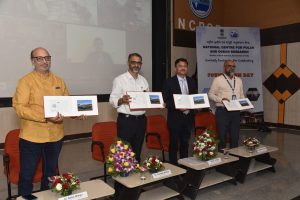 Chief Postmaster General Mumbai, Shri K.K. Sharma, officiated the opening, unveiling a special Picture Postcard of Bharati Station that was released on the occasion with the presence of Shri. R. P. Patil, Director Postal Services, Goa Region, Dr. Thamban Meloth, Director NCPOR, Dr. Rahul Mohan, Group Director and Scientist at NCPOR and the Team leaders of Maitri and Bharati Stations.
Chief Postmaster General Mumbai, Shri K.K. Sharma, officiated the opening, unveiling a special Picture Postcard of Bharati Station that was released on the occasion with the presence of Shri. R. P. Patil, Director Postal Services, Goa Region, Dr. Thamban Meloth, Director NCPOR, Dr. Rahul Mohan, Group Director and Scientist at NCPOR and the Team leaders of Maitri and Bharati Stations.
K K Sharma said the new venture “underscores the commitment of the postal fraternity to serve even the most remote corners of the globe. The department had earlier installed a post office at Dakshin Gangotri Station in 1984 and another at Maitri Station in 1990. He commended the efforts of all the people involved in making this launch possible and expressed confidence in the postmaster stationed at the Bharati Branch Post Office to facilitate meaningful connections through the exchange of letters with loved ones.
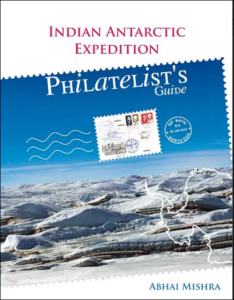 India’s first post office in Antarctica was setup in 1984 at the Dakshin Gangotri Station, which was the country’s first scientific base there, according to a report by Indian Express. Around 10,000 letters and mails had been posted and cancelled at the icy continent’s post office. Significance of post office with Indian address in Antarctica The Antarctica has 2 research stations – Maitri and Bharati – both are a part of the Goa postal division.
India’s first post office in Antarctica was setup in 1984 at the Dakshin Gangotri Station, which was the country’s first scientific base there, according to a report by Indian Express. Around 10,000 letters and mails had been posted and cancelled at the icy continent’s post office. Significance of post office with Indian address in Antarctica The Antarctica has 2 research stations – Maitri and Bharati – both are a part of the Goa postal division.
Apart from senior postal department officials, a number of scientists working in Antarctica and was followed by the defacing of the stamps on the postcards by the first Branch Postmaster of Bharati Post Office, Shri. Sudhanshu.
Dr. Thamban Meloth, Director of NCPOR, highlighted the significance of having an Indian Branch Post Office in the icy continent of Antarctica.
Dr. Anand Kumar Singh presided over the function.
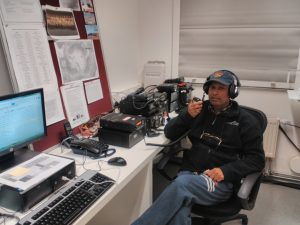 In the list taken from the dedicated Indian philately history of Abhai Mishra’s book (see http://www.waponline.it/antarctic-philately-by-abhay-mishra/). Among the Honorary Post Masters of India’s Antarctic Post Office from the 7th Indian Scientific Expedition to Antarctica (ISEA) through the 32nd ISEA, we found our good friend Bhagwati Prasad Semwal (picture aside) Licensed Ham Radio operator , callsigns: VU3BPZ, Ex-AT10BP, VU3BPZ/P, ex-Antarctican participating the ISEAs XX, XXIV, XXIX and XXXII at Bharati as 8T2BH, who was Post Master himself at Maitri Station.
In the list taken from the dedicated Indian philately history of Abhai Mishra’s book (see http://www.waponline.it/antarctic-philately-by-abhay-mishra/). Among the Honorary Post Masters of India’s Antarctic Post Office from the 7th Indian Scientific Expedition to Antarctica (ISEA) through the 32nd ISEA, we found our good friend Bhagwati Prasad Semwal (picture aside) Licensed Ham Radio operator , callsigns: VU3BPZ, Ex-AT10BP, VU3BPZ/P, ex-Antarctican participating the ISEAs XX, XXIV, XXIX and XXXII at Bharati as 8T2BH, who was Post Master himself at Maitri Station.
The first Indian Scientific Expedition to Antarctica was initiated in 1981.
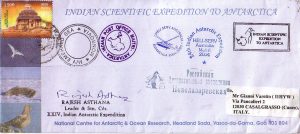 In 1988-89, the Dakshin Gangotri Station (WAP IND-Ø1) was decommissioned as it was submerged in the continent’s ice and in January 26 1990, a new post office branch was built at the continent’s India Maitri Research Station (WAP IND-Ø3), according to the publication. For over 35 years since then, placed in blank envelopes, letters and postcards were sent to the Maitri station’s post office for cancellation. According to the publication, now, almost 40 years later, the letters which are to be sent to Antarctica, will now be having a new Pin Code – MH-1718.
In 1988-89, the Dakshin Gangotri Station (WAP IND-Ø1) was decommissioned as it was submerged in the continent’s ice and in January 26 1990, a new post office branch was built at the continent’s India Maitri Research Station (WAP IND-Ø3), according to the publication. For over 35 years since then, placed in blank envelopes, letters and postcards were sent to the Maitri station’s post office for cancellation. According to the publication, now, almost 40 years later, the letters which are to be sent to Antarctica, will now be having a new Pin Code – MH-1718.
Read more at: https://www.deccanherald.com/india/significance-of-the-indian-post-office-in-antarctica-with-a-new-pin-code-for-letters-postcards-2968404
TNX and credit NCPOR
 HI Folks,
HI Folks, LT Danilo Collino IZ1KHY/IAØ should be shotly active (SSB) from Little Dome C- Beyond Epica camp (WAP MNB-15)
LT Danilo Collino IZ1KHY/IAØ should be shotly active (SSB) from Little Dome C- Beyond Epica camp (WAP MNB-15)
 SWAIS2C, acronym for “
SWAIS2C, acronym for “ West Antarctica is largely covered by the Antarctic ice sheet, but there have been signs that climate change is having some effect and that this ice sheet may have started to shrink slightly. Over the past 50 years, the west coast of the Antarctic Peninsula has been – and still is – one of the most rapidly warming parts of the planet. and the coasts of the Peninsula are the only parts of West Antarctica that become (in summer) ice-free.
West Antarctica is largely covered by the Antarctic ice sheet, but there have been signs that climate change is having some effect and that this ice sheet may have started to shrink slightly. Over the past 50 years, the west coast of the Antarctic Peninsula has been – and still is – one of the most rapidly warming parts of the planet. and the coasts of the Peninsula are the only parts of West Antarctica that become (in summer) ice-free.  SWAIS2C drill sites are:
SWAIS2C drill sites are:  Crary Ice Rise Site 1 or
Crary Ice Rise Site 1 or  What do the researchers study in the most remote scientific corner of Ukraine, at the Antarctic Station “Academic Vernadsky”
What do the researchers study in the most remote scientific corner of Ukraine, at the Antarctic Station “Academic Vernadsky”  The airfields of the Russian Stations Novolazarevskaya (WAP RUS-Ø9 &
The airfields of the Russian Stations Novolazarevskaya (WAP RUS-Ø9 &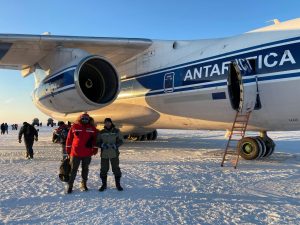
 Russian specialists will provide conditions for safe landing on ice and snow runways for about 20 flights of the IL-76 aircraft giant, whose take-off weight exceeds 200 tons. The Zenit airfield at Progress station is the only site in the world that allows heavy aircraft on wheeled landing gear to be taken to the snow strip. Six flights are expected there this season, with scientists from Russia, China and India arriving. The first flight to Progress Base has already delivered a team of Russian builders and materials for equipping a new wintering complex at the Vostok intercontinental station. The sledge-crawler trek will go deep into the continent in just a few days” said Alexander Makarov, director of the Arctic and Antarctic Research Institute
Russian specialists will provide conditions for safe landing on ice and snow runways for about 20 flights of the IL-76 aircraft giant, whose take-off weight exceeds 200 tons. The Zenit airfield at Progress station is the only site in the world that allows heavy aircraft on wheeled landing gear to be taken to the snow strip. Six flights are expected there this season, with scientists from Russia, China and India arriving. The first flight to Progress Base has already delivered a team of Russian builders and materials for equipping a new wintering complex at the Vostok intercontinental station. The sledge-crawler trek will go deep into the continent in just a few days” said Alexander Makarov, director of the Arctic and Antarctic Research Institute On the mean time, Oleg Sakharov ZS1ANF who is at Cape Town at the moment, has just called to inform that he is preparing for the next season in Antarctica, where he will be at Wolf’s Fang Runway (
On the mean time, Oleg Sakharov ZS1ANF who is at Cape Town at the moment, has just called to inform that he is preparing for the next season in Antarctica, where he will be at Wolf’s Fang Runway (
 Lt. Danilo Collino (pic to the Left) has departed this morning at 03:00UTC from Milan-Airport heading Antarctica, Danilo will sign IZ1KHY/IAØ from few different locations; Concordia (
Lt. Danilo Collino (pic to the Left) has departed this morning at 03:00UTC from Milan-Airport heading Antarctica, Danilo will sign IZ1KHY/IAØ from few different locations; Concordia ( Brabant Island, 64°27’ South, 62°14’ West is nearly 561m long and 24km wide and is the second largest island in the Palmer Archipelago. At one time it was one of the largest still to be explored in the world. It lies 400km south of the Antarctic convergence and east of Grahamland, sitting in a rather weather-beaten zone where winds are regularly above force 12.
Brabant Island, 64°27’ South, 62°14’ West is nearly 561m long and 24km wide and is the second largest island in the Palmer Archipelago. At one time it was one of the largest still to be explored in the world. It lies 400km south of the Antarctic convergence and east of Grahamland, sitting in a rather weather-beaten zone where winds are regularly above force 12. Most of the members of the expeditions weren’t university-level scientists but rather experienced mountaineers. This gap was however filled by the support of numerous research institutions including, among many others, the Belgian Antarctic Committee. An impressive total of 60 scientific projects were carried out, covering topics ranging from natural sciences to sociology and human physiology. “This diversity of aim is, we believe, only possible in a Service expedition such as this free from the constraints of publication, academic rivalry and the need for immediate results.
Most of the members of the expeditions weren’t university-level scientists but rather experienced mountaineers. This gap was however filled by the support of numerous research institutions including, among many others, the Belgian Antarctic Committee. An impressive total of 60 scientific projects were carried out, covering topics ranging from natural sciences to sociology and human physiology. “This diversity of aim is, we believe, only possible in a Service expedition such as this free from the constraints of publication, academic rivalry and the need for immediate results. Base Camp was right in the middle of a colony and the smell took some getting used to. The expeditionners set about unpacking and organising their 15 tonnes of kit. Farewells were brief and the 12 man team had started its big adventure. The first few weeks flew by as we erected a small tri-wall hut for use as a laboratory and a meeting place, and carefully worked out the stores and food area. This had to be marked and carefully recorded for soon it would be buried in snow. With a ready stock of most small things in the hut annex, the stores system worked very well, and only occasionally they have to dig in to find a some of the items
Base Camp was right in the middle of a colony and the smell took some getting used to. The expeditionners set about unpacking and organising their 15 tonnes of kit. Farewells were brief and the 12 man team had started its big adventure. The first few weeks flew by as we erected a small tri-wall hut for use as a laboratory and a meeting place, and carefully worked out the stores and food area. This had to be marked and carefully recorded for soon it would be buried in snow. With a ready stock of most small things in the hut annex, the stores system worked very well, and only occasionally they have to dig in to find a some of the items The barely known history of an Argentine Antarctic shelter, the Teniente Luis Oscar Ventimiglia Hut, installed by the Argentine Antarctic Institute on Peter I Øy (Peter I Island) in March 1971 has been reported on some dedicated articles from which, WAP has taken an abstract.
The barely known history of an Argentine Antarctic shelter, the Teniente Luis Oscar Ventimiglia Hut, installed by the Argentine Antarctic Institute on Peter I Øy (Peter I Island) in March 1971 has been reported on some dedicated articles from which, WAP has taken an abstract. ) was made possible by the use of coloured smoke grenades to visualize the ground. Once on land, Mackinlay expressed his profound happiness, claiming to have been waiting 18 years for that moment since the first conceived plan onboard the ARA Bahía Buen Suceso in 1953.
) was made possible by the use of coloured smoke grenades to visualize the ground. Once on land, Mackinlay expressed his profound happiness, claiming to have been waiting 18 years for that moment since the first conceived plan onboard the ARA Bahía Buen Suceso in 1953. Ulloa, the shelter was inaugurated with the name Teniente Luis Oscar Ventimiglia at 68°42’South, 90° 36’East.
Ulloa, the shelter was inaugurated with the name Teniente Luis Oscar Ventimiglia at 68°42’South, 90° 36’East. Last season a number of construction milestones including making the new science and operations facility, the Discovery Building, weathertight and the runway replacement lighting becoming operational has been completed. The upgrades completed to the runway lighting and operational equipment ensure resilience and maintain safe flying operations at Rothera Station (
Last season a number of construction milestones including making the new science and operations facility, the Discovery Building, weathertight and the runway replacement lighting becoming operational has been completed. The upgrades completed to the runway lighting and operational equipment ensure resilience and maintain safe flying operations at Rothera Station ( The Antarctica shown at the Liguria DX meeting by one of the most experienced veterans of the Italian expeditions in the White Continent, has received appreciable approval from the participants at the Meeting organized by the ARI (Italian Radioamateurs Association) of Sanremo in the wonderful Riviera, not too far away the French border.
The Antarctica shown at the Liguria DX meeting by one of the most experienced veterans of the Italian expeditions in the White Continent, has received appreciable approval from the participants at the Meeting organized by the ARI (Italian Radioamateurs Association) of Sanremo in the wonderful Riviera, not too far away the French border.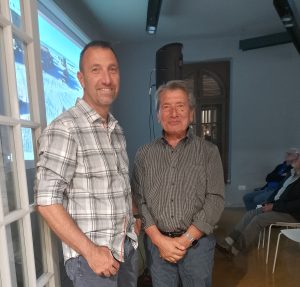
 TNX
TNX  Blaiklock Island Refuge located on the North side of Blaiklock Island at 67°32’South, 67°12’West, was established in 1957 and used intermittently from 1957 to 1958 as a refuge and satellite base for survey and geological parties from nearby bases.
Blaiklock Island Refuge located on the North side of Blaiklock Island at 67°32’South, 67°12’West, was established in 1957 and used intermittently from 1957 to 1958 as a refuge and satellite base for survey and geological parties from nearby bases. Find out more at:
Find out more at:  Next Saturday, October 5th, in the wonderful and famous setting of the city of Sanremo, Liguria Region on the Italian Riviera, the local Amateur Radio Club has organized a DX Meeting where, in addition to various technical topics relating to the world of radio, a special section is dedicated to Antarctica.
Next Saturday, October 5th, in the wonderful and famous setting of the city of Sanremo, Liguria Region on the Italian Riviera, the local Amateur Radio Club has organized a DX Meeting where, in addition to various technical topics relating to the world of radio, a special section is dedicated to Antarctica.
 This year, is quite possible that Danilo IAØ/IZ1KHY will work again in tandem with his friend David Brunet FT4YM who will be in Antarctica as well in the same period.
This year, is quite possible that Danilo IAØ/IZ1KHY will work again in tandem with his friend David Brunet FT4YM who will be in Antarctica as well in the same period. The objective was to support the actions aimed at crossing the Antarctic below the Antarctic Circle, at the height of the Argentine Base San Martin, and also to annually install a scientific shelter so that it could be used by the members of that Polar exploration. A snowmobile provided by Tierra del Fuego (
The objective was to support the actions aimed at crossing the Antarctic below the Antarctic Circle, at the height of the Argentine Base San Martin, and also to annually install a scientific shelter so that it could be used by the members of that Polar exploration. A snowmobile provided by Tierra del Fuego ( In the following years, the construction of new shelters in homage to other native peoples of Tierra del Fuego would continue. (
In the following years, the construction of new shelters in homage to other native peoples of Tierra del Fuego would continue. (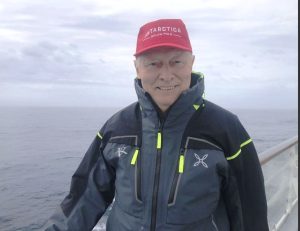 This week, our friend and
This week, our friend and 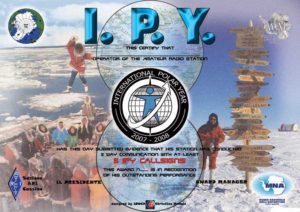 Why an International Polar Year in 2032–33?
Why an International Polar Year in 2032–33? The
The  East Base,
East Base,  East Base was established in 1939 by the U.S. Antarctic Service Expedition, constructed in 1940 and occupied by them from 1940 to 1941. Later it was reoccupied in 1947-48 by the private Finn Ronne Antarctic Expedition. This marked a period of cooperation between the American and British stations, according to the history told by the British.
East Base was established in 1939 by the U.S. Antarctic Service Expedition, constructed in 1940 and occupied by them from 1940 to 1941. Later it was reoccupied in 1947-48 by the private Finn Ronne Antarctic Expedition. This marked a period of cooperation between the American and British stations, according to the history told by the British.  The Antarctic Service Expedition was the first government-funded expedition of Admiral Richard E. Byrd (his first two expeditions in 1928–1930 and 1933–1935 were privately funded). East Base was built using Army knockdown buildings and a crew of 23 led by Richard Black, after Admiral Byrd had to return to Washington on the USS Bear.
The Antarctic Service Expedition was the first government-funded expedition of Admiral Richard E. Byrd (his first two expeditions in 1928–1930 and 1933–1935 were privately funded). East Base was built using Army knockdown buildings and a crew of 23 led by Richard Black, after Admiral Byrd had to return to Washington on the USS Bear. The war time pressures and pack-ice in the bay which prevented ship movement led to the evacuation of the base in 1941 by air. Admiral Richard Byrd’s USAS Expedition built America’s earliest remaining Antarctic camp in March 1940; 4 prefabricated structures were built on: Main Building, Science Building, Machine Shop, and Outpost Hut , from which they explored and mapped Alexander Island, George VI Sound, and hundreds of miles of coastline.
The war time pressures and pack-ice in the bay which prevented ship movement led to the evacuation of the base in 1941 by air. Admiral Richard Byrd’s USAS Expedition built America’s earliest remaining Antarctic camp in March 1940; 4 prefabricated structures were built on: Main Building, Science Building, Machine Shop, and Outpost Hut , from which they explored and mapped Alexander Island, George VI Sound, and hundreds of miles of coastline.

 Brno University of Technology and Masaryk University present a proposal for a new research station module on Nelson Island in Antarctica. The station will be used by the Czech Antarctic Research Program based at the Faculty of Science of Masaryk University.
Brno University of Technology and Masaryk University present a proposal for a new research station module on Nelson Island in Antarctica. The station will be used by the Czech Antarctic Research Program based at the Faculty of Science of Masaryk University.  which is supported by the faculties and institutes of the Technical University in Brno, a technological partner of the Czech Antarctic Research Program.
which is supported by the faculties and institutes of the Technical University in Brno, a technological partner of the Czech Antarctic Research Program. This module is used for testing architectural and technical solutions proposed by the Faculty of Architecture of the Technical University and for the presentation of Czech Antarctic Research.
This module is used for testing architectural and technical solutions proposed by the Faculty of Architecture of the Technical University and for the presentation of Czech Antarctic Research. WAP
WAP
 Maximilian Maria Kolbe, born Rajmund Kolbe (Zduńska Wola, January 8, 1894 – Auschwitz, August 14, 1941), was a Polish priest and Franciscan friar who offered to take the place of a father destined for the hunger bunker in the Auschwitz concentration camp.
Maximilian Maria Kolbe, born Rajmund Kolbe (Zduńska Wola, January 8, 1894 – Auschwitz, August 14, 1941), was a Polish priest and Franciscan friar who offered to take the place of a father destined for the hunger bunker in the Auschwitz concentration camp. Aniversary of Saint Maximilian Kolbe, Saint Patron of Hamradio operators, Radioclub Islas Canarias has been awarded a special callsign
Aniversary of Saint Maximilian Kolbe, Saint Patron of Hamradio operators, Radioclub Islas Canarias has been awarded a special callsign  The US Cape Crozier hut at 77° 27′ 41″ South, 169° 11′ 13″ East, is situated on the NW side of a low peak (675 m) NW of Post Office Hill. A message post from Scott’s National Antarctic Expedition (1901-04) is situated in West Colony (169° 14′ 37.5″ E, 77° 27′ 16.7″ S) and was designated as Historic Site and Monument (HSM) No.69 through Measure 4 (1995). The area is Antarctic Specially Protected Area (ASPA) No. 124.
The US Cape Crozier hut at 77° 27′ 41″ South, 169° 11′ 13″ East, is situated on the NW side of a low peak (675 m) NW of Post Office Hill. A message post from Scott’s National Antarctic Expedition (1901-04) is situated in West Colony (169° 14′ 37.5″ E, 77° 27′ 16.7″ S) and was designated as Historic Site and Monument (HSM) No.69 through Measure 4 (1995). The area is Antarctic Specially Protected Area (ASPA) No. 124. An Automatic Weather Station (AWS) named Laurie II is istalled at Cape Crozier, situated on the Ross Ice Shelf 35 km east of Cape Crozier. Air temperatures recorded at Laurie II between 2009-13 showed December as the warmest month over this period, with a mean temperature of -5.8º C, and August as the coolest with a mean temperature of -33.1º C.
An Automatic Weather Station (AWS) named Laurie II is istalled at Cape Crozier, situated on the Ross Ice Shelf 35 km east of Cape Crozier. Air temperatures recorded at Laurie II between 2009-13 showed December as the warmest month over this period, with a mean temperature of -5.8º C, and August as the coolest with a mean temperature of -33.1º C. The nearest protected areas to Cape Crozier are on Ross Island: Lewis Bay (ASPA No.156), the site of the 1979 DC-10 passenger aircraft crash is the closest and 45 km west; Tramway Ridge (ASPA No.130) near the summit of Mt. Erebus is 55 km west; Discovery Hut on the Hut Point Peninsula (ASPA No.158 and HSM No.18); Arrival Heights (ASPA No.122) is 70 km to the SW adjacent to McMurdo Station; Cape Royds (ASPA No.121), Backdoor Bay (ASPA No.157 and HSM No.15) and Cape Evans (ASPA No.155) are 75 km west; and New College Valley (ASPA No.116) are 75 km NW at Cape Bird.
The nearest protected areas to Cape Crozier are on Ross Island: Lewis Bay (ASPA No.156), the site of the 1979 DC-10 passenger aircraft crash is the closest and 45 km west; Tramway Ridge (ASPA No.130) near the summit of Mt. Erebus is 55 km west; Discovery Hut on the Hut Point Peninsula (ASPA No.158 and HSM No.18); Arrival Heights (ASPA No.122) is 70 km to the SW adjacent to McMurdo Station; Cape Royds (ASPA No.121), Backdoor Bay (ASPA No.157 and HSM No.15) and Cape Evans (ASPA No.155) are 75 km west; and New College Valley (ASPA No.116) are 75 km NW at Cape Bird. I was thrust into the hurly burly of Base routine prior to Christmas 1972 as a rush replacement for t w e appointed postmaster who was repatriated. A hurried week of medicals, x-rays, a dental check up, and a brush up on Post Office procedures, plus settling of my private affairs, was a prelude to the trip South.
I was thrust into the hurly burly of Base routine prior to Christmas 1972 as a rush replacement for t w e appointed postmaster who was repatriated. A hurried week of medicals, x-rays, a dental check up, and a brush up on Post Office procedures, plus settling of my private affairs, was a prelude to the trip South. On 7 february 1959 while officially Australia took over operational command, the remaining US personnel at Wilkes did not take kindly to being under Australian control.
On 7 february 1959 while officially Australia took over operational command, the remaining US personnel at Wilkes did not take kindly to being under Australian control.  he’s fighting to achieve a very specific goal: that of obtaining the recognition of Antarctic Specially Protected Area (
he’s fighting to achieve a very specific goal: that of obtaining the recognition of Antarctic Specially Protected Area ( The largest and only independent Italian Antarctic expedition was led by Renato Cepparo in 1976-77 to the South Shetland lslands by the Norwegian ship Rig Mare. It was privately funded and fully self-suffícient. and had the aim of carrying out scientific measurements and leaving a pemanent refuge on the Antarctic Peninsula. Fifteen men, among whom were the deputy leader Flavio Barbiero, a medicai doctor, two divers and four mountaineers who climbed seven peaks on King George Island, were put ashore at King George Island. The geologists Gian Camillo Cortemiglia and Remo Terranova were in charge of the scientific part. Cepparo and his companions landed on King George Island and erected a small building that they named after Giacomo Bove. Today the only remains are the abandoned walls of the station and a wooden table. inscribed by Ing. Admiral Flavio Barbiero. The area stili keeps the name Italia Valley.
The largest and only independent Italian Antarctic expedition was led by Renato Cepparo in 1976-77 to the South Shetland lslands by the Norwegian ship Rig Mare. It was privately funded and fully self-suffícient. and had the aim of carrying out scientific measurements and leaving a pemanent refuge on the Antarctic Peninsula. Fifteen men, among whom were the deputy leader Flavio Barbiero, a medicai doctor, two divers and four mountaineers who climbed seven peaks on King George Island, were put ashore at King George Island. The geologists Gian Camillo Cortemiglia and Remo Terranova were in charge of the scientific part. Cepparo and his companions landed on King George Island and erected a small building that they named after Giacomo Bove. Today the only remains are the abandoned walls of the station and a wooden table. inscribed by Ing. Admiral Flavio Barbiero. The area stili keeps the name Italia Valley. In 2018 in Cervignano del Friuli (Italy), thank to the inexhaustible commitment of Prof. Julius Fabbri (
In 2018 in Cervignano del Friuli (Italy), thank to the inexhaustible commitment of Prof. Julius Fabbri ( In addition a 1:50 scale model of the “Giacomo Bove” Base (
In addition a 1:50 scale model of the “Giacomo Bove” Base ( COMNAP
COMNAP  The Council of Managers of National Antarctic Programs Annual General Meeting (
The Council of Managers of National Antarctic Programs Annual General Meeting ( The 46th Antarctic Treaty Consultative Meeting was held with an overarching theme of Tasudhaiva Kutumbakam a Sanskrit phrase which means one Earth, one Family, one Future. This resonates deeply with the Antarctic Treaty System, promoting peace, scientific cooperation. and preservation of Antarctica for mankind.
The 46th Antarctic Treaty Consultative Meeting was held with an overarching theme of Tasudhaiva Kutumbakam a Sanskrit phrase which means one Earth, one Family, one Future. This resonates deeply with the Antarctic Treaty System, promoting peace, scientific cooperation. and preservation of Antarctica for mankind. 45th Antarctic Treaty Consultative Meeting – Twenty-fifth Meeting of the Committee for Environmental Protection. Helsinki, Finland – 29 May 2023 – 8 Jun 2023
45th Antarctic Treaty Consultative Meeting – Twenty-fifth Meeting of the Committee for Environmental Protection. Helsinki, Finland – 29 May 2023 – 8 Jun 2023 Decisive has been the help of Scott WA4TTK who did provide his QSL of the contact with Jim Collinson W8IJK/KC4.
Decisive has been the help of Scott WA4TTK who did provide his QSL of the contact with Jim Collinson W8IJK/KC4. Hello Gianni,
Hello Gianni,  Shackleton Field Camp (aka Shackleton Glacier Camp SHG) is located at 85°05’24” South, 175°19’48” West and lists on WAP-WADA Directory as
Shackleton Field Camp (aka Shackleton Glacier Camp SHG) is located at 85°05’24” South, 175°19’48” West and lists on WAP-WADA Directory as 

 On Tuesday 25th 2024, the New Zealand Hercules flew from Auckland to Christchurch, taking off at 02:00 local time and arriving at Phoenix Airfield (WAP USA-42) in Antarctica at 08:50.
On Tuesday 25th 2024, the New Zealand Hercules flew from Auckland to Christchurch, taking off at 02:00 local time and arriving at Phoenix Airfield (WAP USA-42) in Antarctica at 08:50. Concordia Station (
Concordia Station ( 43 years old, has been selected as station leader of the XX Winter Campaign of the
43 years old, has been selected as station leader of the XX Winter Campaign of the  Also from the Ukrainian Vernadsky Station (
Also from the Ukrainian Vernadsky Station ( On the occasion of this year’s Midwinter Day,
On the occasion of this year’s Midwinter Day,  that have been made in polar science at this time. The
that have been made in polar science at this time. The  shared with a new generation keen to learn about Antarctica. We also support other organisations to look after British Antarctic heritage sites in other parts of Antarctica. It is active in the promotion of Antarctic public engagement and supports institutions who have a connection to Antarctic heritage through their collections or education and outreach.
shared with a new generation keen to learn about Antarctica. We also support other organisations to look after British Antarctic heritage sites in other parts of Antarctica. It is active in the promotion of Antarctic public engagement and supports institutions who have a connection to Antarctic heritage through their collections or education and outreach. with all the Antarctic chasers and followers. Thanks to eveyone sharing happyness with us on the Midwinter 2024 by sending us greetings and wishes.
with all the Antarctic chasers and followers. Thanks to eveyone sharing happyness with us on the Midwinter 2024 by sending us greetings and wishes.



 After suffering from a progressive illness that had recently kept him away from amateur radio, Cosme Alfonso “Pupi” Averna died last june 19 2024 in Ushuaia (
After suffering from a progressive illness that had recently kept him away from amateur radio, Cosme Alfonso “Pupi” Averna died last june 19 2024 in Ushuaia ( He was born in Bahía Blanca on July 3, 1948 and at a very young age, he joined the Argentine Navy. In 1984 he was assigned to the Ushuaia Naval Base where he worked in the Weapons Workshop, specializing in ammunition and explosives, retiring after reaching the hierarchy. of Senior Warrant Officer.
He was born in Bahía Blanca on July 3, 1948 and at a very young age, he joined the Argentine Navy. In 1984 he was assigned to the Ushuaia Naval Base where he worked in the Weapons Workshop, specializing in ammunition and explosives, retiring after reaching the hierarchy. of Senior Warrant Officer. Once he retired from his work activity, he bought a motor home with which he traveled thousands of kilometers throughout Argentina for years, visiting colleagues with whom he had made friends through the radio.
Once he retired from his work activity, he bought a motor home with which he traveled thousands of kilometers throughout Argentina for years, visiting colleagues with whom he had made friends through the radio.
 A good recall of “Pupi” was sent by Volker DL8JDX, a well known Antarctic veteran; Volker said: « I am very sorry about Pupi LU8XP sk. I had the luck to make acquaintance with him in Ushuaia Jan. 28, 2023 …»
A good recall of “Pupi” was sent by Volker DL8JDX, a well known Antarctic veteran; Volker said: « I am very sorry about Pupi LU8XP sk. I had the luck to make acquaintance with him in Ushuaia Jan. 28, 2023 …» Plateau Station was the highest and most remote scientific station established by the United States. Construction of the site, started on December 13, 1965, and the first Traverse Team (named SPQML II) arrived in early 1966. The station was located at 79° 15’ South, 40° 30’ East in the far interior of the Antarctic ice cap, 11,890 feet above sea level.
Plateau Station was the highest and most remote scientific station established by the United States. Construction of the site, started on December 13, 1965, and the first Traverse Team (named SPQML II) arrived in early 1966. The station was located at 79° 15’ South, 40° 30’ East in the far interior of the Antarctic ice cap, 11,890 feet above sea level. when it was closed but mothballed for future use. Plateau Station was also the coldest of any United States Stations on the Continent and the site for the world’s coldest measured average temperature for a month at that time, recorded in July 1968, at −99.8 °F (−73.2 °C).
when it was closed but mothballed for future use. Plateau Station was also the coldest of any United States Stations on the Continent and the site for the world’s coldest measured average temperature for a month at that time, recorded in July 1968, at −99.8 °F (−73.2 °C). Actually Plateau Station is an inactive American research and support Base on the central Antarctic Plateau.
Actually Plateau Station is an inactive American research and support Base on the central Antarctic Plateau. In 2017, the CoFi-Expedition made a stop at Plateau Station. They entered the Station through a hatch at the top of highest building, the watch tower. The Bse is completely snowbound nowadays. The only visible building at the base is the meteorological tower. The expedition left the base with the same general impression as the expedition in 2007 did.
In 2017, the CoFi-Expedition made a stop at Plateau Station. They entered the Station through a hatch at the top of highest building, the watch tower. The Bse is completely snowbound nowadays. The only visible building at the base is the meteorological tower. The expedition left the base with the same general impression as the expedition in 2007 did.
 Lion Island 66° 39′ 32″ South, 140° 00′ 53″ East is small rocky island 0.2 mi NNE of Petrel Island in the Geologie Archipelago. It was surveyed and named by the French Antarctic Expedition of 1949-51 under André Liotard. The name derives from the rock summit of the island which has the shape of a lion’s head.
Lion Island 66° 39′ 32″ South, 140° 00′ 53″ East is small rocky island 0.2 mi NNE of Petrel Island in the Geologie Archipelago. It was surveyed and named by the French Antarctic Expedition of 1949-51 under André Liotard. The name derives from the rock summit of the island which has the shape of a lion’s head. Pollux Islet a rocky islet in the Pointe-Géologie archipelago (Adelie Land) and Zeus were themselves two rocky islets in the same site; Zeus islet had the bad idea of being located in the axis of this track, between the Pollux islet, 100 mts to the Northwest, and the smallest of the Buffon islands, 100 mts to the southeast. Lamarck Island, a rocky island located 250 mts away to the southeast of Pétrels Island in the fateful NW-SE alignment of Cuvier, Lion and Buffon in the central part of the Pointe-Géologie archipelago, was spared by the construction of the Lion trail.
Pollux Islet a rocky islet in the Pointe-Géologie archipelago (Adelie Land) and Zeus were themselves two rocky islets in the same site; Zeus islet had the bad idea of being located in the axis of this track, between the Pollux islet, 100 mts to the Northwest, and the smallest of the Buffon islands, 100 mts to the southeast. Lamarck Island, a rocky island located 250 mts away to the southeast of Pétrels Island in the fateful NW-SE alignment of Cuvier, Lion and Buffon in the central part of the Pointe-Géologie archipelago, was spared by the construction of the Lion trail. On September 21, 1994, the Minister of the Environment Michel Barnier formalized in the Council of Ministers the abandonment of the Adélie land trail.
On September 21, 1994, the Minister of the Environment Michel Barnier formalized in the Council of Ministers the abandonment of the Adélie land trail. HI Folks,
HI Folks, Not too much to report from Antarctica at this time of the year The White Continent is actually in the deep winter, waiting the 2024-2025 Summer Antarctic Campaign.
Not too much to report from Antarctica at this time of the year The White Continent is actually in the deep winter, waiting the 2024-2025 Summer Antarctic Campaign.

 Here below the sites where David did operate from:
Here below the sites where David did operate from: Antarctic Campaign 2022-23
Antarctic Campaign 2022-23 The “Capitán Estivariz Aeronaval Refuge”, is located on Watkins Island in the Mikkelsen islands group (
The “Capitán Estivariz Aeronaval Refuge”, is located on Watkins Island in the Mikkelsen islands group ( Note:
Note: The Base “Y” at Horseshoe Island (
The Base “Y” at Horseshoe Island ( VP8DLM operated by Mehdi F5PFP was active from this rare site on March 2011, giving many of the Antarctic hunters a real
VP8DLM operated by Mehdi F5PFP was active from this rare site on March 2011, giving many of the Antarctic hunters a real  Polish Demay Refuge provide limited accommodation capacity for 4 people with field medical kit available during summer for emergency use. The scientific use, is subject to the permission of the appropriate authority. The refuge (wood hut) is situated on a flat marine gravel terrace in Paradise Cove between Demay Point and Uchatka Point, ca 10 km from Arctowski Station (
Polish Demay Refuge provide limited accommodation capacity for 4 people with field medical kit available during summer for emergency use. The scientific use, is subject to the permission of the appropriate authority. The refuge (wood hut) is situated on a flat marine gravel terrace in Paradise Cove between Demay Point and Uchatka Point, ca 10 km from Arctowski Station ( Lions Rump Refuge
Lions Rump Refuge  Probably, the old days, those in which CW and SSB were the best expression of the world of Amateur Radio will never come back, but fortunately, there are still young people that, to the most modern digital transmission/reception techniques (such as FT4/FT8, in which is the PC that makes QSOs), those youngs prefere the traditional ways, those that truly have the charm that takes you inside!
Probably, the old days, those in which CW and SSB were the best expression of the world of Amateur Radio will never come back, but fortunately, there are still young people that, to the most modern digital transmission/reception techniques (such as FT4/FT8, in which is the PC that makes QSOs), those youngs prefere the traditional ways, those that truly have the charm that takes you inside!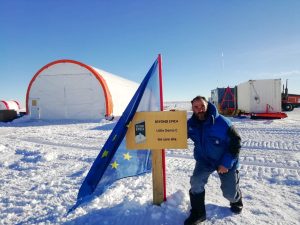 website: “I relive good memories as I read her lines, emotions arise and fingers frozen too” was his comment!
website: “I relive good memories as I read her lines, emotions arise and fingers frozen too” was his comment! Petrel Base opened in 1967 but has been used as a temporary summer base since 1976, after a fire destroyed its main accommodation building. Petrel Base (
Petrel Base opened in 1967 but has been used as a temporary summer base since 1976, after a fire destroyed its main accommodation building. Petrel Base ( The New Petrel structure took into account all the technological innovations of recent decades and all the scientific knowledge about the climatic and geographical conditions of Antarctica that was produced at this time. We also studied the projects of Countries that built Antarctic bases in recent years.
The New Petrel structure took into account all the technological innovations of recent decades and all the scientific knowledge about the climatic and geographical conditions of Antarctica that was produced at this time. We also studied the projects of Countries that built Antarctic bases in recent years. Ranui Station (aka North Hut-Ranui lookout hut) located at Port Ross on Auckland Island at 50°32’3Ø” South, 166°15’4Ø” East was maintained by a Team of 4-5 men from 1941 until 3 June, 1945. The first recruits came from the NZ Post & Telegraph Service, but from 1942 scientists were included. Various scientific work took place from wildlife research to detailed meteorological observations. During 1944-45, a survey party led by Flight Commander Allan Eden undertook the first full topographical survey of the Auckland Island group. The complex, included a base hut, ancillary huts, long drops, radio masts, landing areas, and tracks hidden in the rata forest, out of sight from the sea. The hut itself is located
Ranui Station (aka North Hut-Ranui lookout hut) located at Port Ross on Auckland Island at 50°32’3Ø” South, 166°15’4Ø” East was maintained by a Team of 4-5 men from 1941 until 3 June, 1945. The first recruits came from the NZ Post & Telegraph Service, but from 1942 scientists were included. Various scientific work took place from wildlife research to detailed meteorological observations. During 1944-45, a survey party led by Flight Commander Allan Eden undertook the first full topographical survey of the Auckland Island group. The complex, included a base hut, ancillary huts, long drops, radio masts, landing areas, and tracks hidden in the rata forest, out of sight from the sea. The hut itself is located  just below the ridge above the base and provides a clear view of all the entrances to Port Ross. At first, private messages were restricted to bereavement or other urgent matters, but later each man was allowed to send and receive two personal messages annually. The only news of the outside world was that heard over standard domestic radio, and other morse code transmissions picked up by the radio operators.
just below the ridge above the base and provides a clear view of all the entrances to Port Ross. At first, private messages were restricted to bereavement or other urgent matters, but later each man was allowed to send and receive two personal messages annually. The only news of the outside world was that heard over standard domestic radio, and other morse code transmissions picked up by the radio operators. ZL9/K8VIR & ZL9DX did operate from Ranui Cove (WAP NZL-Ø9) in the year 1997 …. Maybe it’s time for some others DX-peditionners to try again, isn’t it?
ZL9/K8VIR & ZL9DX did operate from Ranui Cove (WAP NZL-Ø9) in the year 1997 …. Maybe it’s time for some others DX-peditionners to try again, isn’t it? Prefabricated 3m square huts of weatherboard construction with bitumen roofs were shipped to the Auckland Island in 1941. One was built at Port Ross in the North and the other at Carnley Harbour on the South end of the island.
Prefabricated 3m square huts of weatherboard construction with bitumen roofs were shipped to the Auckland Island in 1941. One was built at Port Ross in the North and the other at Carnley Harbour on the South end of the island.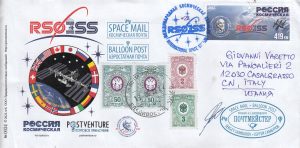 Radio amateur’s passion is often linked to “Philately”, especially that which recalls the Arctic and Antarctica but also, always in terms of radio contacts, also to the Space as in the case of the International Space Station
Radio amateur’s passion is often linked to “Philately”, especially that which recalls the Arctic and Antarctica but also, always in terms of radio contacts, also to the Space as in the case of the International Space Station  A hobby or a passion?
A hobby or a passion?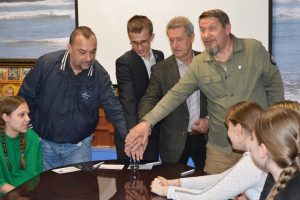 travel researcher, postal historian, winner of the “Geographical Oscar”, author of the term “philaturism” presented by “Bottle Mail”, “Traveller’s Mail” and “Polar Mail“, which include postcards, vignette stamps and a special postmark, Valery Ivanovich Sushkov RMØL and students at one of the secondary schools in Ryazan.
travel researcher, postal historian, winner of the “Geographical Oscar”, author of the term “philaturism” presented by “Bottle Mail”, “Traveller’s Mail” and “Polar Mail“, which include postcards, vignette stamps and a special postmark, Valery Ivanovich Sushkov RMØL and students at one of the secondary schools in Ryazan.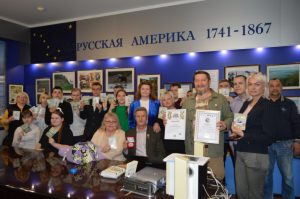 The purpose of the historical-geographical, scientific-educational, film-publishing, tourism-local history and memorial Project “Great Russian Travelers” is the revival of the traditions of Russian travelers in research and discovery, the popularization and promotion of tourism and postal business, highlighting their contribution to the economy of Russian society and the development of ties between the peoples of different countries.
The purpose of the historical-geographical, scientific-educational, film-publishing, tourism-local history and memorial Project “Great Russian Travelers” is the revival of the traditions of Russian travelers in research and discovery, the popularization and promotion of tourism and postal business, highlighting their contribution to the economy of Russian society and the development of ties between the peoples of different countries.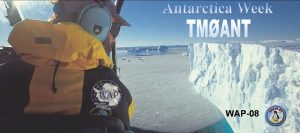 We must say that the 1st edition (2004) of the
We must say that the 1st edition (2004) of the 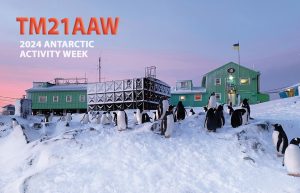 The picture on TM21AAW’s card, shows the Ukranian Antarctic Akademic Vernadsky Station (WAP UKR-Ø1) located at 65˚14′ South, 64˚15′ West, Marina Point on GalindezIsland in the Argentine islands Archipelago. The Faraday British Research base was established there in 1947 and transferred to Ukraine in 1996.
The picture on TM21AAW’s card, shows the Ukranian Antarctic Akademic Vernadsky Station (WAP UKR-Ø1) located at 65˚14′ South, 64˚15′ West, Marina Point on GalindezIsland in the Argentine islands Archipelago. The Faraday British Research base was established there in 1947 and transferred to Ukraine in 1996.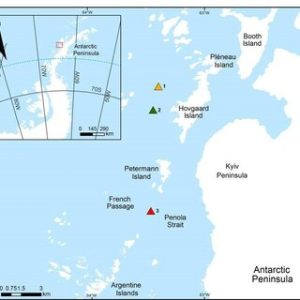 beauty. On those occasions, a “Field Camp” is installed and who knows… maybe one day even an expedition of radio amateurs will give us the pleasure of this “
beauty. On those occasions, a “Field Camp” is installed and who knows… maybe one day even an expedition of radio amateurs will give us the pleasure of this “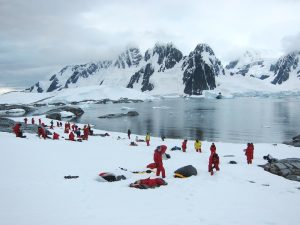 has overtaken the original name in usage. The name Krogmann Point has been given to the western extremity of Hovgaard Island.
has overtaken the original name in usage. The name Krogmann Point has been given to the western extremity of Hovgaard Island.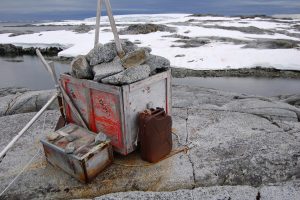 gently sloping smooth rock and snow.
gently sloping smooth rock and snow.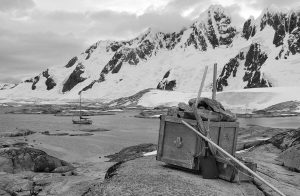 The cache is located up high on weathered stone where it is unlikely to be troubled by snow or ice during the winter. The cache contains emergency supplies for trapped ship-wrecked expedition; inside will be timed food, fire supplies and a tent.
The cache is located up high on weathered stone where it is unlikely to be troubled by snow or ice during the winter. The cache contains emergency supplies for trapped ship-wrecked expedition; inside will be timed food, fire supplies and a tent.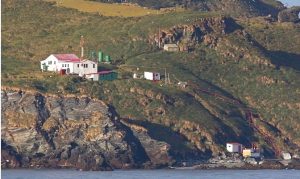 Gonzalo Island (56° 31’ 15” South, 68° 42’ 40” West), is a Sub-Antarctic island, uninhabited except for a Weather and Research Station (
Gonzalo Island (56° 31’ 15” South, 68° 42’ 40” West), is a Sub-Antarctic island, uninhabited except for a Weather and Research Station (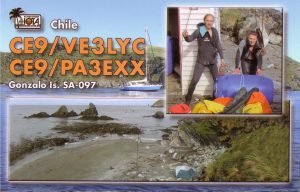
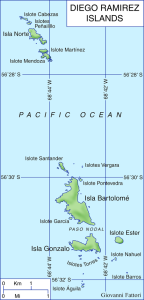 The important mission of the Diego Ramirez Island Lighthouse
The important mission of the Diego Ramirez Island Lighthouse April 5th 2024, INDIA’s NCPOR 24th Foundation Day
April 5th 2024, INDIA’s NCPOR 24th Foundation Day In this historic moment, as a part of the foundation day celebrations, the Indian Postal Services, in collaboration with NCPOR, inaugurated a new Branch Post Office at Bharati Station (
In this historic moment, as a part of the foundation day celebrations, the Indian Postal Services, in collaboration with NCPOR, inaugurated a new Branch Post Office at Bharati Station ( Chief Postmaster General Mumbai, Shri K.K. Sharma, officiated the opening, unveiling a special Picture Postcard of Bharati Station that was released on the occasion with the presence of Shri. R. P. Patil, Director Postal Services, Goa Region, Dr. Thamban Meloth, Director NCPOR, Dr. Rahul Mohan, Group Director and Scientist at NCPOR and the Team leaders of Maitri and Bharati Stations.
Chief Postmaster General Mumbai, Shri K.K. Sharma, officiated the opening, unveiling a special Picture Postcard of Bharati Station that was released on the occasion with the presence of Shri. R. P. Patil, Director Postal Services, Goa Region, Dr. Thamban Meloth, Director NCPOR, Dr. Rahul Mohan, Group Director and Scientist at NCPOR and the Team leaders of Maitri and Bharati Stations. India’s first post office in Antarctica was setup in 1984 at the Dakshin Gangotri Station, which was the country’s first scientific base there, according to a report by Indian Express. Around 10,000 letters and mails had been posted and cancelled at the icy continent’s post office. Significance of post office with Indian address in Antarctica The Antarctica has 2 research stations – Maitri and Bharati – both are a part of the Goa postal division.
India’s first post office in Antarctica was setup in 1984 at the Dakshin Gangotri Station, which was the country’s first scientific base there, according to a report by Indian Express. Around 10,000 letters and mails had been posted and cancelled at the icy continent’s post office. Significance of post office with Indian address in Antarctica The Antarctica has 2 research stations – Maitri and Bharati – both are a part of the Goa postal division.  In the list taken from the dedicated Indian philately history of Abhai Mishra’s book (see
In the list taken from the dedicated Indian philately history of Abhai Mishra’s book (see  In 1988-89, the Dakshin Gangotri Station (
In 1988-89, the Dakshin Gangotri Station ( Igor is very active on all bands, Actually it’s easy to work him CW on 10 mts as conditions seems to be good on 28 MHz, but also 20 & 40 mts.
Igor is very active on all bands, Actually it’s easy to work him CW on 10 mts as conditions seems to be good on 28 MHz, but also 20 & 40 mts.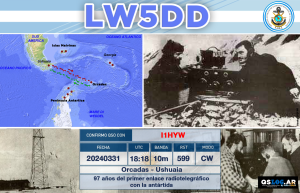 It was a chance with profound symbolic value; losing it would have been a real shame.
It was a chance with profound symbolic value; losing it would have been a real shame.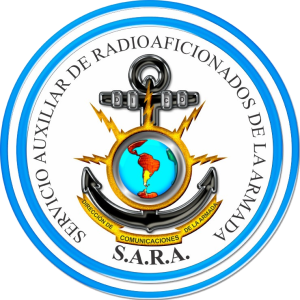
 when the sounds of the Morse alphabet were heard for the first time in Antarctica; fundamental step in the development of communications at those latitudes, That day at the Meteorological Observatory of the South Orkney Islands, the Orkney Station (LRT) was officially inaugurated.
when the sounds of the Morse alphabet were heard for the first time in Antarctica; fundamental step in the development of communications at those latitudes, That day at the Meteorological Observatory of the South Orkney Islands, the Orkney Station (LRT) was officially inaugurated. When on that historic day, March 30, 1927, the Morse sounds of the letters were heard and repeated at rhythmic intervals: “LRT… LRT…”, everyone shouted in unison “We… We… Finally …Finally…”, the question was: Who is calling us? and immediately you could hear “LRT… LRT… de LIK… LIK… LIK…”; exclaiming all together “They’re calling us from Ushuaia.”
When on that historic day, March 30, 1927, the Morse sounds of the letters were heard and repeated at rhythmic intervals: “LRT… LRT…”, everyone shouted in unison “We… We… Finally …Finally…”, the question was: Who is calling us? and immediately you could hear “LRT… LRT… de LIK… LIK… LIK…”; exclaiming all together “They’re calling us from Ushuaia.”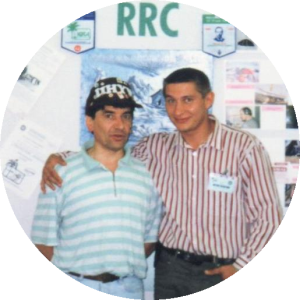 Ham Radio is something of incredibile!
Ham Radio is something of incredibile! Valery Sushkov RMØL (ex RW3GW) is a travel researcher, postal historian, travel marketer, documentarian, chief postmaster of the International Philaturism Society, author of the new concept of “philaturism” in the history of world tourism practice, curator of the World Postal Mail Museum. Head of the Project “POSTVENTURE & Postal Adventure”. Visited more than 50 countries of the world, participant and organizer of more than 100 different expeditions on 6 continents, conqueror of the South
Valery Sushkov RMØL (ex RW3GW) is a travel researcher, postal historian, travel marketer, documentarian, chief postmaster of the International Philaturism Society, author of the new concept of “philaturism” in the history of world tourism practice, curator of the World Postal Mail Museum. Head of the Project “POSTVENTURE & Postal Adventure”. Visited more than 50 countries of the world, participant and organizer of more than 100 different expeditions on 6 continents, conqueror of the South 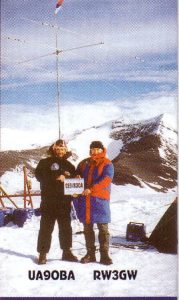 Pole and the highest peak in Africa – Mount Kilimanjaro, member of the Russian Geographical Society – Society for the Study of the Amur Region, member of the Union of Journalists of Russia, laureate and winner of the National Awards of the Russian Geographical Society “Crystal Compass”.
Pole and the highest peak in Africa – Mount Kilimanjaro, member of the Russian Geographical Society – Society for the Study of the Amur Region, member of the Union of Journalists of Russia, laureate and winner of the National Awards of the Russian Geographical Society “Crystal Compass”. Philaturism is educational and adventure tourism and the study of territories through the prism of philately and postal history, something new born from the fervent mondo f Valery!.
Philaturism is educational and adventure tourism and the study of territories through the prism of philately and postal history, something new born from the fervent mondo f Valery!. It’s a real shame! Six people visited Platcha Hut, a brand “New One” for many Antarctic Hunters, and nobody brought an HF Radio, to operate a little while from there, and living us the pleasure to log a rare spot in Antarctica!
It’s a real shame! Six people visited Platcha Hut, a brand “New One” for many Antarctic Hunters, and nobody brought an HF Radio, to operate a little while from there, and living us the pleasure to log a rare spot in Antarctica!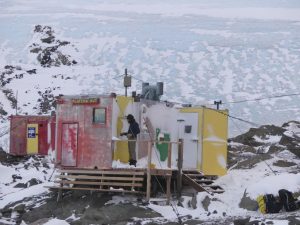 Platcha Hut 68° 30′ 47″ South, 78° 30′ 36″ East is situated in an extemely handy spot at the base of the plateau just to the south of Breid Basin a few metres above the shoreline. The locale is easy to reach by helicopter in the summer and is a decent walk over rough terrain from Davis Station for the keen. In the winter, Platcha Hut is one of the first to be visited once the sea ice forms and is thick enough. From Davis quads or Hägglunds, head along a waypointed route that follows Long Fjord to Breid Basin. The Hut itself sleeps four in bunk beds with room for two in the recently renovated (2011) Met Hut (the original Platcha) at the back.
Platcha Hut 68° 30′ 47″ South, 78° 30′ 36″ East is situated in an extemely handy spot at the base of the plateau just to the south of Breid Basin a few metres above the shoreline. The locale is easy to reach by helicopter in the summer and is a decent walk over rough terrain from Davis Station for the keen. In the winter, Platcha Hut is one of the first to be visited once the sea ice forms and is thick enough. From Davis quads or Hägglunds, head along a waypointed route that follows Long Fjord to Breid Basin. The Hut itself sleeps four in bunk beds with room for two in the recently renovated (2011) Met Hut (the original Platcha) at the back. The present Platcha Hut was built in 1982. On the 9th of September the internal fit-out was transported to Platcha and by the 16th of September the hut was completed and ready for occupation which was a mammoth effort by the wintering team of 1982.
The present Platcha Hut was built in 1982. On the 9th of September the internal fit-out was transported to Platcha and by the 16th of September the hut was completed and ready for occupation which was a mammoth effort by the wintering team of 1982. Luis Risopatrón Refuge is an Antarctic Chilean refuge, located at 60°22’17” South, 59°42’53” West on the north shore of Coppermine Cove, Robert Island in Nelson Strait on South Shetland Islands
Luis Risopatrón Refuge is an Antarctic Chilean refuge, located at 60°22’17” South, 59°42’53” West on the north shore of Coppermine Cove, Robert Island in Nelson Strait on South Shetland Islands Risopatrón, although, due to its characteristics it was known for quite a bit of time, as Luis Risopatrón Refuge. The shelter is located 40 m above sea level, on a solid rock surface, 150 m from the coast. 20 km from the closest base, Captain Arturo Prat, (
Risopatrón, although, due to its characteristics it was known for quite a bit of time, as Luis Risopatrón Refuge. The shelter is located 40 m above sea level, on a solid rock surface, 150 m from the coast. 20 km from the closest base, Captain Arturo Prat, ( Antarctic Base, which did participate in the activities of the International Geophysical Year on March 3, 1957. This Base was set 60 meters from the O’Higgins Base (
Antarctic Base, which did participate in the activities of the International Geophysical Year on March 3, 1957. This Base was set 60 meters from the O’Higgins Base ( Last march 10th 2024, the marathon for the “120th Anniversary” of Argentina’s presence in
Last march 10th 2024, the marathon for the “120th Anniversary” of Argentina’s presence in  All Digital Certificates, available to those who did work the Argentina’s Bases in Antartica and other official LU station which work within the event, could download their own confirmation by entering the QSLOG.AR website at:
All Digital Certificates, available to those who did work the Argentina’s Bases in Antartica and other official LU station which work within the event, could download their own confirmation by entering the QSLOG.AR website at: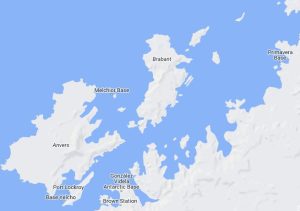 Brabant Island, lying off the west coast of the Antarctic Peninsula at 64°15’South, 62°20’West, is the second largest Island of the Palmer Archipelago within the British Antarctic Territory. Brabant Island, 59 km (37 mi) long north-south, 30 km (19 mi) wide, is lying between Anvers Island and Liège island. It had only been visited on six very brief occasions since its discovery in 1898, although a 1/200 000 topographic map had been produced in 1963 from FIDASE aerial photography.
Brabant Island, lying off the west coast of the Antarctic Peninsula at 64°15’South, 62°20’West, is the second largest Island of the Palmer Archipelago within the British Antarctic Territory. Brabant Island, 59 km (37 mi) long north-south, 30 km (19 mi) wide, is lying between Anvers Island and Liège island. It had only been visited on six very brief occasions since its discovery in 1898, although a 1/200 000 topographic map had been produced in 1963 from FIDASE aerial photography.